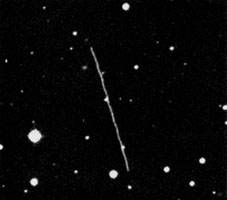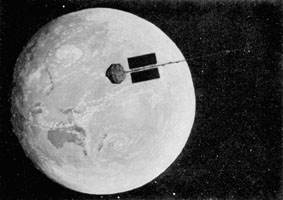by Steve Williams
From L5 News, August 1982
There are three sources of raw materials available to construct facilities in space: the Earth, Moon, and asteroids. Being of small relative size and mass, the asteroids are unique.
The largest asteroid is Ceres. which was also the first to be discovered back in 1800. It has a diameter of 1018 km, less than 1/3 that of the Moon. The asteroids range in size from Ceres down to fine-grained micrometer size dust. Most of the asteroids lie at distances of between 2.1 and 3.3 AU from the sun, though some come much closer. (AU = astronomical unit, which is simply the semi-major axis of the Earth’s orbit, about stat million km. It’s often used by astronomers to measure distances within the Solar System.) The combined mass of the asteroid belt is something like 2 to 4% of the mass of the Moon, this mass being roughly distributed over some 60 trillion cubic kilometers.
An average asteroid we might be interested in mining would have a diameter of about 200 meters. A “carbonaceous asteroid” of this size would have a mass of about 50 ten-gigawatt solar power satellites,
certainly large enough to provide us building material for a long time.
Before we talk about mining these pieces of cosmic debris we must first ask what is their composition and how well do we know it? Because of the Apollo program and six trips to the Moon, we have a very good idea of what is available to us from lunar “dirt.” Our knowledge of the asteroids is a bit more indirect.
Astronomers have been plagued by the asteroids for over a hundred years. While taking a long time-exposure photo of one area of the sky they would occasionally get a long white streak on their plate where some asteroid had moved across the field of view. Eventually they began studying these objects and have amassed a catalog of slightly over 2000. Only in the last 25 years have astronomers been seriously studying the physical

This newly discovered asteroid, 1981 VA, has a perihelion distance which varies from 0.60 AU (inside the orbit of Venus) to 1.12 AU (outside Earth’s orbit). Its aphelion distance varies from 3.80 AU to 4.32 AU, well beyond the main belt asteroids. (Photo courtesy E. Helin, JPL / NASA.)
Information comes from three main sources: photometry, or the variation of brightness with time yielding a light curve; colorimetry, or how the brightness varies with wavelength of the reflected light from the asteroid; and the polarization of the light. From the light curve astronomers determine the shape of the asteroid, how fast it is spinning, and the uniformity of its source composition. (Occasionally an object will be darker on one side than the other.) Colorimetry determines if the asteroid is silicaceous (like the Moon), metallic, or carbonaceous. Polarization determines the texture of the surface. (i.e., is it smooth, rocky, fractured? Is there a regolith?)
The validity of the astronomical data is very much enhanced by examinations of meteorites (asteroids which have made their way to the surface of the earth). It is not too surprising that asteroids and meteorites have similar individual compositions: silicate rich assemblages, metal rich assemblages, and carbonaceous assemblages. Though asteroids/meteorites are often separtated into several dozen different categories, the majority fall into the three above-named divisions.
Of particular interest are the carbonaceous asteroids. They contain in abundance such items as water, carbon, nitrogen, and various hydrocarbons. These items are completely absent or, at best, are only minor trace elements on the Moon. They are quite necessary to support life, as well as being important in many manufacturing processes. In supporting a space habitat / manufacturing facility, most studies currently propose to bring these items up from the Earth. This transportation is costly and pushes up the cost of moving into space.
When moving things around within the Solar System, the most important consideration by far is the energy required. This energy is proportional to the square of the change in velocity; this is the source of the familiar acronym delta-V. We pay a considerable penalty in delta-V when bringing things up out of the deep “gravitational well” of the Earth.
Because of this fact we want to look for asteroids which “approach” the Earth and would require less energy to transport to our manufacturing facility in Earth orbit. Quite conveniently there is just such a class of asteroids known as Earth approachers. They generally don’t approach the actual vicinity of the Earth, but their orbits are at some point near the Earth’s orbit. Only about 40 are known, though there are estimated to he some 800 with diameters of at least one kilometer. They originate from two sources: genuine main belt asteroids which have been gravitationally perturbed into their current orbits, and “burnt out” short period comets. The majority are probably carbonaceous.
As discussed in the March 1980 L-5 News, there are a number of ways to transport an asteroid to the Earth-Moon system. Three of the most prominent are a rotary pellet launcher, a linear mass driver, and a light sail. A few of the known Earth-crossing asteroids can be retrieved for about the same energy cost as that for transporting material up from the Moon. We will almost certainly he able to improve on this when we have a more detailed catalog of Earth approachers.

One method that has been suggested for retrieval of asteroids, to bring them into the Earth vicinity, is the use of Gerard O’Neill’s mass driver, as shown in this painting by William Hartman. Hartman is co-author of the hook The Grand Tour, a collection of photos and paintings by William Hartman and Ron Miller.
There are a number of other advantages the Earth-approaching asteroids have over the Moon. As mentioned above we can tap resources in the asteroids not available on the Moon. Solar energy is available only half the time at any given spot on the surface of the Moon to drive a solar power source, whereas it would he constantly available on an asteroid. The logistics of transportation to and from an asteroid is simpler, because there is no need to build a large mass driver, develop a mass catcher, a fleet of lunar launch vehicles, or any of the supporting facilities. The gravitational well of the Moon, though much smaller than Earth’s, must still be overcome. It has been estimated by Brian O’Leary that a 200 meter asteroid could be transported to a space manufacturing facility in high Earth orbit for a comparatively reasonable cost of one billion 1976 dollars.
Another interesting proposal would be to mine a metallic asteroid strictly for its precious metals. A 200 meter asteroid containing only 8.5 parts per million of platinum would contain enough of this metal alone to sell for about $1.4 billion on today’s market. This is particularly interesting when one considers that the world’s primary sources of platinum today are in the Soviet Union and South Africa.
Certainly no one will make a large investment in an asteroid until we have hard evidence of its exact composition. For this reason we should first send an unmanned probe to survey 10 or more of the most promising asteroids, followed by or done in conjunction with a sample test retrieval mission. Right now such a mission would be far more beneficial than those to Saturn, Jupiter, Venus, or Mars. Much could he learned about early conditions in the Solar System, and therefore such a mission would satisfy not only “space industrialists,” but also the pure scientists.
A number of studies have gone into considerable detail on the mining and processing of lunar material to turn out a completed SPS. I would like to see a similar study done on milling and retrieving an Earth-approaching asteroid.
BIBLIOGRAPHY
1. Chapman. CR. “The Nature of Asteroids.” Scientific American, Jan. 1975. Vol. 232, pp. 24-33.
2. Gehrels, T. Asteroids, University of Arizona Press. 1980.
3. Hartman. W.K. Moons and Planets, An Introduction to Planetary Science, 1972. Chapter 8-9.
4. Miller. R.A. and Smith. D.B.S.. et al. “Extra terrestrial Processing and Manufacturing of Large Space Systems,” Final report, NASA Contractor Report CR-161293, Sept. 1979.
5. Nichiporuk, W. and Brown, H. “The Distribution of Platinum and Palladium Metals in Iron Meteorites and in the Metal Phase of Ordinary Chondrites.” Journal of Geophysical Research, Jan. 1975, pp. 459-470.
6. O’Leary. B. “Mining the Apollo and Amor Asteroids.” Science, July 1977, pp. 363-366.
7. Shoemaker, E. M. u/ E. F. “Earth Approaching Asteroids: Population and Compositional Types,” NASA Conference Publication 2053, Jan. 1978, pp. 161-175.







